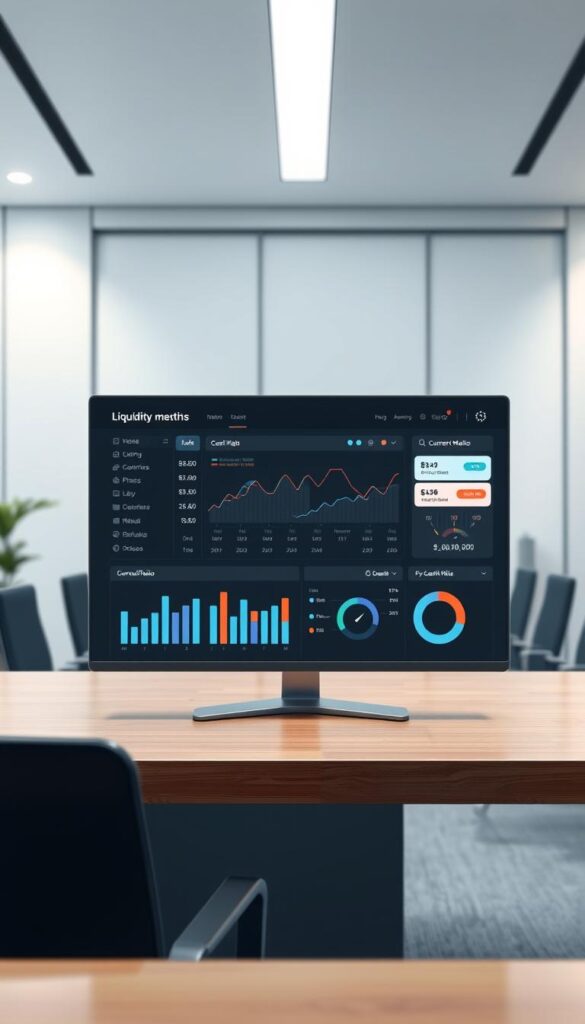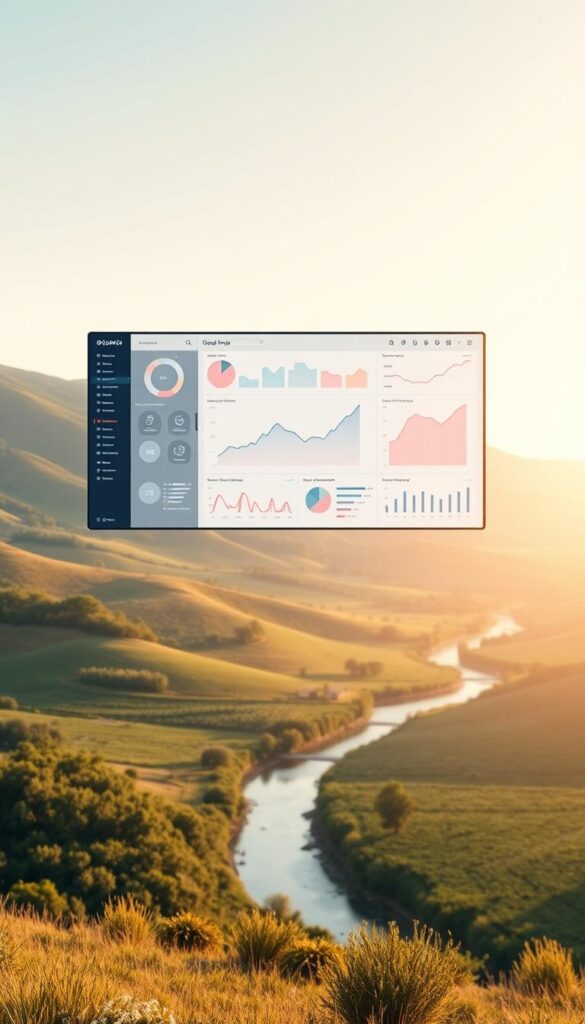Ever wondered why some businesses do well while others struggle? It often comes down to knowing and using Financial KPIs. As a business owner, it’s key to master these indicators to improve your performance and make better decisions.
Financial KPIs show how well your business meets its goals. By tracking the right financial metrics, you can spot trends, set goals, and make smart choices. Knowing which Financial KPIs to track can help your business stay profitable and strong.
We’ll explore the essential financial KPIs every business owner should watch. This way, you can use these insights to grow your business and handle business finance challenges.
Key Takeaways
- Understanding Financial KPIs is vital for business health and strategic decision-making.
- Every business owner should track liquidity, profitability, and efficiency KPIs.
- Revenue growth is a key indicator of overall business performance and sustainability.
- Effective cash flow management can prevent operational challenges and financial strain.
- Utilizing KPIs can lead to improved financial performance and enhanced growth.
Understanding Financial KPIs
Financial KPIs, or Key Performance Indicators, are key tools for checking and improving your financial health. They give a detailed look at your company’s financial state. This includes checking on profits, cash flow, and how liquid you are. Understanding financial KPIs is vital for making smart choices that help your business grow.
Using good performance tracking, you can spot what’s working well and what’s not. KPIs like Net Profit Margin and Return on Investment (ROI) show how well your money is doing. Metrics like Operating Cash Flow (OCF) show how much cash your daily business activities make. This gives a clear view of how well you’re doing.
Also, tracking KPIs like Current Ratio and Working Capital helps keep an eye on your money’s flow and short-term stability. Knowing this lets you plan ahead to avoid problems and grab chances for growth. In the end, really getting financial KPIs helps you tackle challenges and steer your business in the right direction.
The Importance of Financial KPIs for Business Owners
For any business owner, knowing the value of financial KPIs is key to success. These indicators show how well your company is doing financially. They help you see where you’re improving and where you need to work harder.
By watching these numbers closely, you can spot areas to get better. You can also see how you stack up against others in your field. This helps you plan better for the future.
Understanding these metrics helps you make smart choices. For example, looking at cash flow and how much each employee makes helps you see how well your business runs. This info helps you make better decisions and plan for money needs.
Also, tracking these KPIs helps create a culture of responsibility in your team. Everyone knows how their work affects the company’s success. This can make your team more engaged and productive.

Key Financial KPIs Every Business Owner Should Track for Success
Every business owner needs to track key financial KPIs to succeed. These metrics offer deep insights into how well your business is doing. They help you see what success means in numbers.
By looking at total revenue, gross profit margin, and net profit, you get a clear view. A good KPI strategy lets you track results, make changes, and find new opportunities. This way, you can grow your business based on solid data.
Defining Key Financial Performance Indicators
Key financial KPIs show how healthy and sustainable your business is. Here are some important ones to consider:
| KPI | Definition | Importance |
|---|---|---|
| Total Revenue | The overall income from sales. | Shows how much money your business makes, but doesn’t show profit. |
| Cost of Goods Sold (COGS) | Direct costs of making products. | High COGS means you might need to improve how you make things. |
| Gross Profit | Total Revenue minus COGS. | Tells you if your pricing is working well. |
| Net Profit | What’s left after all expenses are paid. | Shows if your business is making money. |
| Cash Flow | Money moving in and out of your business. | Important for knowing if your business can pay its bills. |
How KPIs Drive Business Strategy
A good KPI strategy links your financial goals with your business plan. By tracking key metrics, you can spot trends and adjust your strategy. For instance, if you see revenue growing or cash flow changing, you might need to tweak your plan.
This approach helps your business stay flexible and strong. It encourages you to always look for ways to improve and grow, even in tough times.
Liquidity KPIs and Their Role in Financial Health
Understanding liquidity KPIs is key to knowing if a company is financially stable in the short term. These indicators show if you can meet immediate financial needs. This is important for keeping your business running smoothly and avoiding cash flow problems.
Current Ratio
The current ratio is a basic liquidity KPI. It compares your current assets to your current liabilities. A ratio of 1.0 or more means your business can handle short-term costs well. This boosts your financial health.
Quick Ratio
The quick ratio is a stricter measure of liquidity. It excludes inventory from current assets. This ratio is great for businesses that use a lot of inventory. It gives a true picture of your financial situation.
Cash Ratio
The cash ratio is the most conservative way to check liquidity. It looks at how much cash you have to cover current liabilities. High values mean you have enough cash, showing strong financial health. Watching these KPIs helps spot cash flow issues early.

Profitability KPIs: Measuring Business Efficiency
Profitability KPIs are key to seeing if a business makes more money than it spends. They help you understand if your business is doing well and make smart choices. The main KPIs are the gross profit margin and net profit margin. These numbers show how well your business runs and keeps profits up.
Gross Profit Margin
The gross profit margin shows what’s left of revenue after you pay for goods sold. It’s calculated as (Revenue – Cost of Sales) / Revenue * 100. This KPI tells you about your pricing and how efficient you are in making things.
Net Profit Margin
The net profit margin shows how profitable your business is after all costs are paid. It’s Net Profit / Revenue * 100. A high net profit margin means your business is good at turning revenue into profit, showing it’s efficient.
Operating Margin
The operating margin looks at how efficient your business is by subtracting all operating costs from revenue. It’s important for seeing how well you manage daily operations and keep profits up. Keeping an eye on these KPIs helps you make choices that grow your business.
Efficiency KPIs: Tracking Operational Success
Efficiency KPIs are key to seeing how well your company uses its resources. Companies that focus on efficiency can grab market chances better and do financially well. Key metrics like accounts receivable turnover show how fast you turn credit sales into cash. Days payable outstanding and inventory turnover ratio give deep insights into cash and inventory management.
Accounts Receivable Turnover
Accounts receivable turnover shows how good you are at collecting debts. A high ratio means you collect debts fast, avoiding cash flow issues. Keeping an eye on this helps improve cash flow and efficiency.
Days Payable Outstanding
This metric looks at how long it takes to pay suppliers. A lower number means better cash flow management. By adjusting payment terms, you can keep cash for other needs, boosting success.
Inventory Turnover Ratio
The inventory turnover ratio shows how fast you sell and replace stock. A high ratio means you manage inventory well, cutting costs and risks. It shows you can meet market demands efficiently.
![]()
| Efficiency KPIs | Description |
|---|---|
| Accounts Receivable Turnover | Measures how quickly you collect cash from credit sales. |
| Days Payable Outstanding | Assesses how efficiently you pay your suppliers. |
| Inventory Turnover Ratio | Indicates how fast your inventory is sold and replaced. |
Checking these efficiency KPIs often can spot issues early. This lets you make smart, timely decisions to boost efficiency and success.
Revenue Tracking: The Heart of Business Growth
Tracking revenue is key for any business looking to grow. It helps understand sales growth and revenue per employee. These insights show how well your business is doing and guide future plans.
Sales Growth Rate
The sales growth rate shows how much sales have increased over time. It shows if your business is growing and meeting market needs. Keeping a high sales growth rate is important for businesses looking to expand.
By watching this number, you can spot trends. This helps you adjust your plans to meet customer needs better.
Revenue per Employee
Revenue per employee looks at how well your team is selling. It shows if your business is using its resources well. A high number means your team is working efficiently, making your business more profitable.
![]()
Benchmarking Your Financial KPIs Against Industry Standards
Benchmarking financial KPIs against industry standards helps you see how your company stacks up against competitors. It shows you what you’re doing well and what needs work. This way, you can make smart choices to stay ahead in the game.
Look closely at financial indicators like growth, profitability, and liquidity. These numbers give you a clear picture of your financial health. They help you spot trends and make plans that match industry standards. Keeping a close eye on these helps you improve over time.
Companies that check their KPIs often find ways to get better. Studies show they’re 20% more likely to find these chances than those who don’t. Focusing on net profit margin and gross profit margin helps you build a strong financial plan. This way, you can find ways to make more money.
Good benchmarking is about more than just looking at numbers. It’s about linking them to your business goals. This connection is key to success. It makes your team work harder to meet goals and keeps your KPIs up to date with the changing business world.

Customer Acquisition and Retention Metrics
Understanding customer acquisition and retention metrics is key for business growth. These metrics show how well your business gets new customers and keeps old ones. By tracking these, you learn about customer behavior, profitability, and business health.
Customer Lifetime Value (CLV)
Customer lifetime value (CLV) is vital. It shows the total money you can make from one customer over time. You calculate it by multiplying Average Purchase Value, Average Purchase Frequency, and Average Customer Lifespan. Knowing CLV helps you decide where to spend your resources for the best return. High CLV means loyal customers who boost your profits.
Customer Churn Rate
The customer churn rate shows how many customers leave your business over time. A high rate can mean problems like bad service or unhappy customers. Watching this metric helps you improve customer loyalty and keep more customers.

Setting Targets and Monitoring Progress
Setting clear financial targets is key for any business to succeed. It helps you track your progress and see how well you’re doing. Financial projections are important here, giving you a peek into your future profits and needs.
These forecasts also help spot problems before they get big. This way, you can plan ahead and avoid surprises.
The Role of Financial Projections
Financial projections are like a map for your company’s financial future. They include things like how much money you’ll make and how much you’ll spend. This lets you see where you are now and what you might need later.
Being proactive with these projections helps you fine-tune your plans. This keeps you on track with your big goals.
Using KPI Dashboards for Real-Time Analysis
KPI dashboards let you check your progress as it happens. They show important numbers in a clear, easy-to-see way. This makes it simple to understand how your company is doing at a glance.
With regular updates, you get quick access to key data. This helps you make smart choices fast. Being able to track KPIs means you can quickly adapt to new situations. This keeps your goals in sight.

| KPI | Measurement | Target Example |
|---|---|---|
| Revenue Growth Rate | % increase in sales over a period | 15% growth in 6 months |
| Net Profit Margin | % of revenue after all expenses | 20% margin by year-end |
| Accounts Receivable Turnover | Net Annual Credit Sales ÷ Average Accounts Receivable | 6 times annually |
Making Data-Driven Decisions with Financial KPIs
Using financial KPIs helps you make data-driven decisions that boost your performance. By tracking these KPIs, you get a clear view of how well your organization is doing. For example, a high accounts receivable turnover shows you’re good at collecting money. And a high inventory turnover means you’re selling products fast and using your money wisely.
Keeping an eye on financial KPIs can lead to better revenue, lower costs, and more efficient operations. It’s key to keep your Customer Acquisition Cost (CAC) low for growth. Knowing your Customer Lifetime Value (CLV) helps you see how much value each customer brings over time. Checking your KPIs regularly helps you stay ahead in your plans.
Using charts and dashboards to see your KPI data makes it easier to understand and share with others. These tools help spot important trends and areas to improve. Using financial software can also make collecting and reporting data easier, cutting down on mistakes and saving time.

Leveraging Financial Analysis for Sustainable Growth
Financial analysis is key to understanding your business’s health and growth. It helps you spot trends for better decision-making. This way, you can make smart choices about how to use resources and improve operations.
For example, a company’s revenue jumped from $1 million to $1.5 million. This 50% increase shows their strategies are working. The gross margin of 40% with sales of $500,000 and COGS of $300,000 shows they’re efficient in production and pricing.
Also, the operating expenses ratio of 25% with expenses of $200,000 against $800,000 in revenue shows good resource management. A low operating expenses ratio means more profit for investing in growth.
The cash conversion cycle is also important for liquidity. With a cycle of 12.5 days, it shows they manage cash well. This is key for long-term success.
Financial analysis helps you make better plans for the future. It ensures your investments and operations match your growth goals. Knowing your financial metrics well helps make smart decisions for a successful business.

Conclusion
It’s key to understand and keep an eye on your financial KPIs for business success. These indicators help you see how well your finances are doing and make smart choices for growth. By looking at things like net profit margin and accounts receivable turnover, you can understand your company’s health and profits better.
Having a strong KPI framework helps you react quickly to changes in sales and revenue. If you spot areas to improve, like a drop in sales or high customer risk, your business can grow. Good financial tracking makes your company more open and accountable, leading to success.
In today’s fast-changing economy, staying ahead means using data to grow. Relying on accurate financial KPIs helps you make better decisions and stay financially healthy. Use these insights to lead your organization to lasting success.
FAQ
What are financial KPIs?
Why are financial KPIs important for business owners?
Which financial KPIs should I monitor for my business?
How can I use KPIs to improve my business strategy?
What is liquidity and why is it vital?
How do profitability KPIs inform my business operations?
What are some strategies for tracking efficiency KPIs?
How can I benchmark my financial KPIs?
Why is customer acquisition and retention vital for business growth?
How should I set targets for my financial KPIs?
How do I make data-driven decisions using financial KPIs?
What is the role of financial analysis in my business?
Source Links
- Financial KPIs for Small Businesses: Your Success Metrics – https://northstar-bookkeeping.com/blog/what-financial-kpis-should-a-small-business-owner-track/
- Top 20 Financial KPIs That You Should Keep Track – https://devrix.com/tutorial/financial-kpis-business-owner-track/
- Financial KPIs Every Small Business Should Track – https://kashoo.com/blog/financial-key-performance-indicators-kpis-every-small-business-should-track/
- Council Post: To Drive Business Performance, You Must Understand KPIs – https://www.forbes.com/councils/forbesbusinesscouncil/2024/07/03/to-drive-business-performance-you-must-understand-kpis/
- 14 Financial KPIs Every Small Business Owner Should Track (and Why) – https://www.fastcapital360.com/blog/top-financial-kpis-to-measure-business-performance/
- Small Business KPIs: What Are the Numbers That Matter? – https://www.uschamber.com/co/run/finance/measure-small-business-kpis
- The 5 Most Important Business Metrics Every Owner Should Track – Cyfe – https://www.cyfe.com/blog/3-metrics-to-measure-business-performance/
- The 4 Key Financial Metrics to Track for Business Success – https://www.linkedin.com/pulse/4-key-financial-metrics-track-business-success-fiona-schneider
- 5 Key Financial Metrics Every Business Owner Should Know | CFO2GO Program Insights — SCARLET THREAD CONSULTING – https://www.scarletthreadconsulting.com/scarlet-thread-consulting/5-key-business-metrics-every-business-owner-should-know
- Essential Financial Metrics Every Small Business Owner Should Track – https://invoicecrowd.com/essential-financial-metrics-every-small-business-owner-should-track/
- Top Key Performance Indicators Every Business Should Track | www.financialhotspot.com – https://financialhotspot.com/2025/01/01/top-key-performance-indicators-every-business-should-track/
- Essential Financial KPIs Every Business Owner Should Track – https://www.linkedin.com/pulse/essential-financial-kpis-every-business-owner-xsdof
- What are the most important finance department KPIs to track? | UCFS – https://www.ucfs.net/what-are-the-most-important-finance-department-kpis-to-track/
- 13 Financial Performance Measures Managers Should Monitor – https://online.hbs.edu/blog/post/financial-performance-measures
- 13 Essential Small Business Metrics to Track Performance | OptimoRoute – https://optimoroute.com/small-business-metrics/
- 25+ KPIs and Metrics for Finance Departments in 2024 – https://insightsoftware.com/blog/kpis-and-metrics-for-finance-departments/
- How to Strengthen Your Organization with Operational KPIs – https://www.mossadams.com/articles/2024/04/strengthen-financials-with-operational-kpis
- Key Performance Indicators (KPIs): How to Identify, Track, Measure – https://lifthcm.com/article/key-performance-indicators-kpis
- Top 3 Financial KPIs Every Business Owner Should Track | Lutz – https://www.lutz.us/blog/financial-kpis-every-business-should-track
- Measuring Success: The KPIs Every Business Should Be Tracking—And How a Fractional CFO Can Help – https://cathcap.com/measuring-success-the-kpis-every-business-should-be-tracking-and-how-a-fractional-cfo-can-help/
- 25+ Key Performance Indicators (KPIs) to Measure Performance – https://blog.proactioninternational.com/en/how-to-measure-a-company-performance
- Critical Questions Every Business Owner Should Ask About Metrics – https://www.linkedin.com/pulse/critical-questions-every-business-owner-should-ask-metrics-hallgren
- Retention KPIs: How to Measure and Improve Customer Retention | Userflow Blog – https://www.userflow.com/blog/retention-kpis-how-to-measure-and-improve-customer-retention
- The Essential KPIs Every Business Should Track for Success – https://www.whizconsulting.net/us/blog/essential-kpis-every-business-should-track/
- 21 financial KPIs and metrics you should track in 2025 – https://www.thoughtspot.com/data-trends/dashboard/financial-kpis-and-metrics-dashboard-examples
- 7 financial KPIs to track for company growth and success | Spendesk – https://www.spendesk.com/blog/financial-kpis/
- Council Post: How To Harness The Power Of KPIs For Business Success – https://www.forbes.com/councils/forbesfinancecouncil/2024/08/06/how-to-harness-the-power-of-kpis-for-business-success/
- KPIs: What Are Key Performance Indicators? Types and Examples – https://www.investopedia.com/terms/k/kpi.asp
- Financial KPIs for Measuring Your Business Success – https://preferredcfo.com/insights/key-performance-indicators
- 15 Financial KPIs And Metrics Every Business Should Track (+ Template) – https://www.cascade.app/blog/financial-kpis
- 5 Essential Financial KPIs Every FP&A Manager Should Track – https://www.linkedin.com/pulse/5-essential-financial-kpis-every-fpa-manager-should-track-ehab-sobhy
- CFO KPIs & Metrics for Success – https://www.invoiced.com/resources/blog/cfo-kpis-metrics
- The 5 Most Important Financial KPIs That Drive Business Strategy | FreshBooks Blog – https://www.freshbooks.com/blog/financial-kpis-strategy?srsltid=AfmBOopGxv7R4YP2hWFP0P4ftL9QqFUkVxNqQHLeRASbeFbr1ngknZkM
- What KPIs should you be tracking in your business? – de Jong Phillips – https://www.dejongphillips.co.uk/2022/09/01/what-kpis-should-you-be-tracking-in-your-business/
- 17 Key Business Metrics You Should Track to Find Success – https://www.liveplan.com/blog/planning/what-startup-metrics-should-i-track?srsltid=AfmBOopsudJyg5ocOfm3J6NoPaMm8p-BrdK2eQNvT-uE_entRdIXaipP